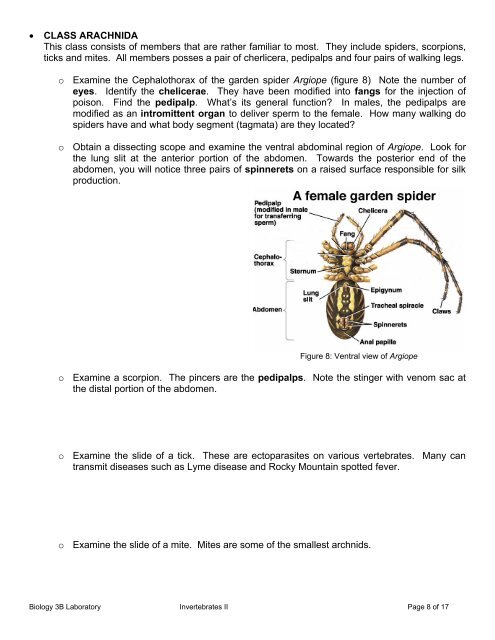Biology 3B Laboratory Invertebrates II: Annelida, Nematoda ...
Biology 3B Laboratory Invertebrates II: Annelida, Nematoda ...
Biology 3B Laboratory Invertebrates II: Annelida, Nematoda ...
You also want an ePaper? Increase the reach of your titles
YUMPU automatically turns print PDFs into web optimized ePapers that Google loves.
• CLASS ARACHNIDA<br />
This class consists of members that are rather familiar to most. They include spiders, scorpions,<br />
ticks and mites. All members posses a pair of cherlicera, pedipalps and four pairs of walking legs.<br />
o Examine the Cephalothorax of the garden spider Argiope (figure 8) Note the number of<br />
eyes. Identify the chelicerae. They have been modified into fangs for the injection of<br />
poison. Find the pedipalp. What’s its general function? In males, the pedipalps are<br />
modified as an intromittent organ to deliver sperm to the female. How many walking do<br />
spiders have and what body segment (tagmata) are they located?<br />
o Obtain a dissecting scope and examine the ventral abdominal region of Argiope. Look for<br />
the lung slit at the anterior portion of the abdomen. Towards the posterior end of the<br />
abdomen, you will notice three pairs of spinnerets on a raised surface responsible for silk<br />
production.<br />
Figure 8: Ventral view of Argiope<br />
o Examine a scorpion. The pincers are the pedipalps. Note the stinger with venom sac at<br />
the distal portion of the abdomen.<br />
o Examine the slide of a tick. These are ectoparasites on various vertebrates. Many can<br />
transmit diseases such as Lyme disease and Rocky Mountain spotted fever.<br />
o Examine the slide of a mite. Mites are some of the smallest archnids.<br />
<strong>Biology</strong> <strong>3B</strong> <strong>Laboratory</strong> <strong>Invertebrates</strong> <strong>II</strong> Page 8 of 17

















